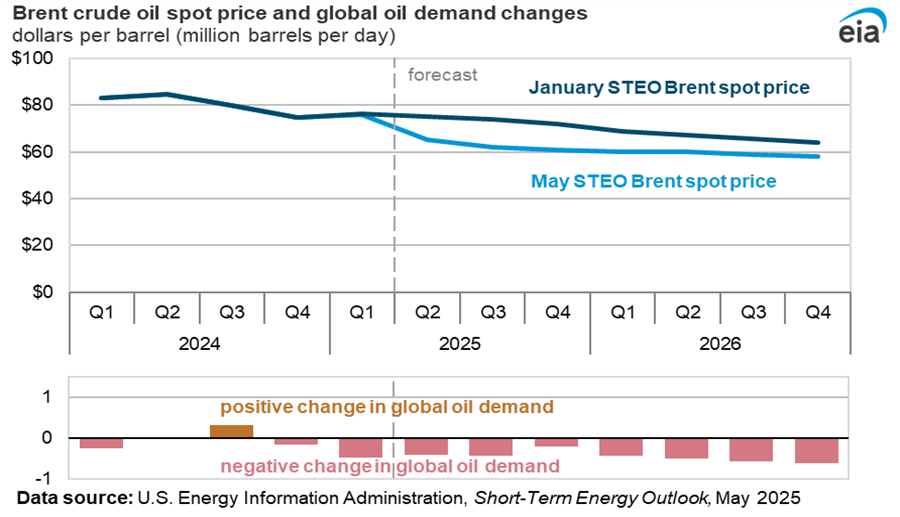Crude oil prices: The Brent crude oil spot price averaged $82 per barrel (b) in January, about $2/b higher than the average in December 2022. Oil prices rose during January in part because of the expectation of increasing oil demand as a result of relaxing COVID-19 restrictions and increasing mobility in China. Perceptions of a less severe recession and some improving macroeconomic conditions also likely contributed to rising crude oil prices over the past month.

Last month, we highlighted oil demand in China and oil production in Russia as two of the main uncertainties in the oil market this year, and we have revised our outlook for both in this month’s forecast. The revisions result from China relaxing COVID restrictions, which have increased our forecast of oil demand growth. At the same time, more oil was produced in Russia than we anticipated during January, and we raised our forecast for Russia’s oil production through the end of 2024. We have also lowered our forecast for oil production in OPEC because of rising global oil inventories. These changes have largely offset each other in our forecast global balances, and beyond the first quarter of 2023, we have left our crude oil price forecast largely unchanged from last month’s outlook.
We expect that the Brent spot price will average $85/b in the first half of 2023 (1H23). However, we expect global oil production to continue to outpace demand over the forecast period, leading to persistent global oil inventory builds through 2024 and falling oil prices. After increasing by an average of 0.6 million b/d in 2022, we expect global oil inventories to also build by an average of 0.6 million b/d in 2023, with builds moderating to 0.4 million b/d in 2024. Correspondingly, our forecast spot price of Brent crude oil falls to an average of $82/b in 2H23 and $78/b in 2024.
Global oil demand: Global liquids fuel consumption in the forecast increases from an average of 99.4 million barrels per day (b/d) in 2022 to 102.3 million b/d in 2024, driven primarily by growth in China and other non-OECD countries. However, significant uncertainty around our demand forecast remains based on possible outcomes for the evolving global economic conditions and China’s pivot away from a zero-COVID strategy. We forecast that the reversal of restrictions will contribute to oil demand in China increasing by 0.7 million b/d in 2023 and by 0.4 million b/d in 2024. We expect OECD oil demand to remain largely flat over the forecast period, as inflationary economic pressures continue to limit GDP and oil demand growth and as the oil intensity of OECD economies declines.
Global oil supply: Global liquid fuels production averaged about 100.0 million b/d in 2022, and we forecast it will increase by an average of 1.1 million b/d in 2023 and 1.5 million b/d in 2024. Growth in non-OPEC production in both 2023 and 2024, as well as increases in OPEC output in 2024, will mostly offset an approximately 1.1 million b/d decline in Russia’s production over the forecast period.
We forecast Russia’s production of petroleum and other liquids to decline to 9.9 million b/d in 2023 from more than 10.9 million b/d in 2022 and then average 9.8 million b/d in 2024. For both 2023 and 2024, we forecast about 0.4 million b/d more production in Russia than in last month’s STEO. We had previously forecast that the majority of Russia’s crude oil exports subject to EU sanctions implemented on December 5 would find new markets, but that the sanctions would lead to some decline in production. However, we assess that Russia’s crude oil exports rose in January after a brief decline in December and have since begun to surpass November totals, with little impact to Russia’s crude oil production.
The EU ban on seaborne imports of petroleum products from Russia that began on February 5 could be more disruptive than the ban on crude oil imports implemented in December. We assume Russia will be able to reroute some of its petroleum exports subject to EU sanctions. But we do not expect all of its refined product exports will find new destinations because of limited clean tanker availability, which will cause refiners in Russia to reduce crude oil inputs and for Russia’s crude oil production to decline.
| Global Petroleum and Other Liquids | ||||
|---|---|---|---|---|
| 2021 | 2022 | 2023 | 2024 | |
| Brent crude oil spot price (dollars per barrel) | 70.89 | 100.94 | 83.63 | 77.57 |
| Global liquid fuels production (million barrels per day) | 95.70 | 99.95 | 101.10 | 102.61 |
| OPEC liquid fuels production (million barrels per day) | 31.66 | 34.17 | 34.08 | 34.77 |
| Non-OPEC liquid fuels production (million barrels per day) | 64.03 | 65.78 | 67.02 | 67.85 |
| Global liquid fuels consumption (million barrels per day) | 97.12 | 99.36 | 100.47 | 102.26 |
| Global GDP (percentage change) | 6.2 | 3.2 | 1.8 | 3.3 |

